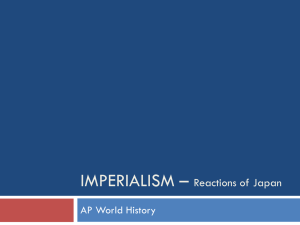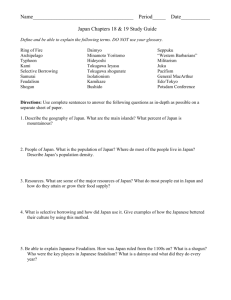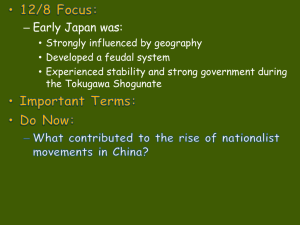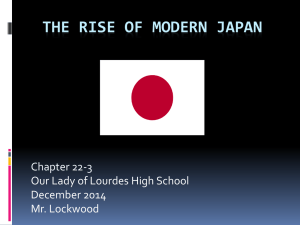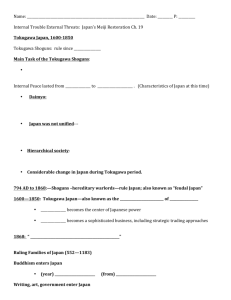Imperialism in Japan
advertisement
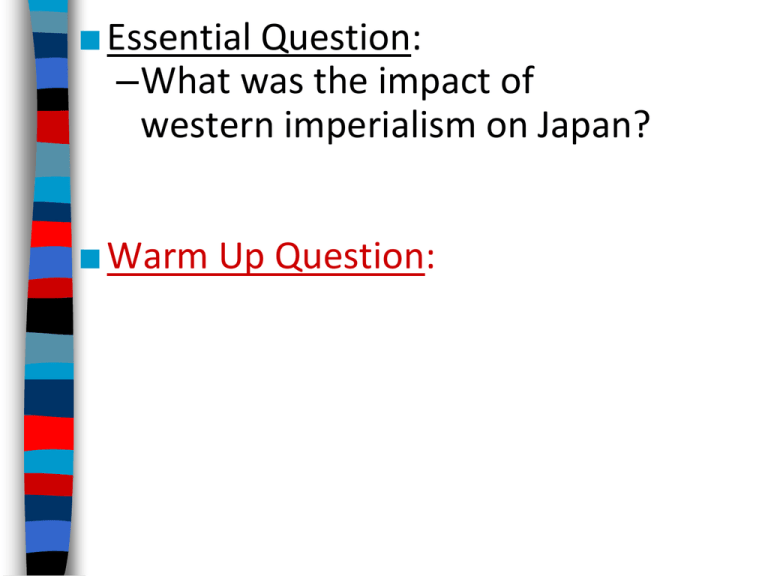
■ Essential Question: –What was the impact of western imperialism on Japan? ■ Warm Up Question: Western imperialism in Asia dramatically changed Japan Let’s quickly review Japanese history ■ Text Ancient Japan was a territory Title divided by clans that borrowed ideas from China, like Buddhism, emperors, writing, & architecture By the mid 11th century, Emperor had little power Japanese feudalism began Japan was ruled by regional landowners called daimyo Daimyo were served by loyal warriors called samurai From 1192 to 1867, Japan was ruled by military dictators called shogun From 1560 to 1600, 3 powerful shogun, unified Japan Tokugawa Ieyasu unified Japan in 1600 & created a strong line Toyotomi Hideyoshi Oda Tokugawa Nobunaga Ieyasu of succession called the Tokugawa Shogunate that ruled Japan until 1867 European merchants Japanese shogun enjoyed & missionaries first trade with Europeans & were arrived in Japan fascinated by their military & in the mid-1500s technologies But the rapid conversion of Japanese to Christianity worried Tokugawa who banned Christianity in 1619 To protect Japan from By 1639, Japan adopted European influences, a “closed country policy” Tokugawa Shogunate & Japan entered an banned all foreign era of isolation that merchants & missionaries lasted for 200 years Nagasaki Bay Deshima Dutch Ships During this era of isolation, the Japanese allowed one port at Deshima in Nagasaki Bay to remain open but only to Dutch & Chinese merchants The Japanese did more than trade with the Dutch, they also learned from them about new Western ideas These “Dutch studies” helped Japan learn about some of the new scientific & industrial technologies in Europe Microscope, Steam engine, 17871845 Anatomy Railroad, book, 1774 1845 Electric Steamboat, battery,1845 1840 From 1640 to 1853, Japan was isolated while the Title by Western powers rest of Asia became imperialized In the early 1800s, Britain, France, Russia, & USA tried to negotiate trade rights in Japan The Japanese repeatedly refused Western trade In 1853, U.S. Commodore Critical Thinking Matthew Perry arrived in Tokyo Decision #1: Harbor with 4 well-armed, The Arrival of steamships & demanded that Americans in 1853 the Japanese trade with the USA Japan’s Response: C Japanese officials realized they were overmatched by U.S. naval ships When Matthew Perry returned in 1854, Japanese officials signed the Treaty of Kanagawa which opened two ports to American merchants After the United States opened the door to Japanese trade in 1854, other Western powers entered Japan By 1860, England, France, the Dutch, Russia, & USA all had unequal trade treaties & extraterritorial rights in Japan Critical Thinking Decision #2: The Meiji Restoration ■ Text Japan’s Response: B Japanese were angry that the shogun had given in to foreigner’s demands & feared Japan would become as powerless as China In 1867, the Tokugawa shogun stepped down which brought an end to 600 years of military dictatorship Emperor Mutsuhito took control of the government & took the title “Meiji” (“enlightened rule”) The Meiji emperor Japan sent diplomats to realized the best way to Europe & America to study end Western influence Western ways & adapt was to modernize them to their own country Japan admired Germany’s government & used it as a model to create a new constitution and parliament Japanese leaders eagerly supported industrialization & began building modern factories… …railroads, steamships, & steel bridges Title Japan built a modern military by modeling their army after the Germans & their navy after the British Japanese officials reformed education using models Title from German, America, & French public schools ■ Text Western fashions became popular in Japan Modernization in the Meiji era transformed Japan into the most industrial &Land militarizedPublic nation in Asia schools End of the (Germany, USA, Redistribution By 1900,feudal Japan had 7,000 The Meiji reforms gave system & France) miles of railroad track; Japan power & respect; thousands of factories; Japanese nationalism led profitable tea, silk, to the end to Western Modern Modernize shipbuilding industries; & extraterritorial rights & banking system the Army Meiji an modern army & navy unequal trade(Germany) treaties Reforms Written Critical Thinking Constitution (Germany) Decision #3: Japanese reforms & Human Rights industrialization & Religious Freedom Build a Japan’s Response: D Modern Navy (Britain) Emperor Worship Intensified By the 1890s, Japan saw itself as a modern nation that needed raw materials Like other industrialized nations, Japan began to imperialize in Asia Japan looked to take Korea, but China always had a claim to the land The dispute with China over Korea resulted in the Sino-Japanese War from 1894 to 1895 In a short time, Japan defeated the Chinese army & destroyed their navy For their victory, Japan gained Taiwan & spheres of influence in China This woodblock print is an almost perfect example of Title how the Japanese (left) saw themselves as totally different from the Chinese and fundamentally similar ■to Text the Westerners, seen here in the figures of Western advisors (right) standing behind the Chinese After Japan’s victory over China, a rivalry developed between Japan & Russia From 1904 to 1905 Russo-Japanese War began over control of Port Arthur & Manchuria During the war, In 1905, U.S President Teddy Japan shocked the Roosevelt helped draft the world by defeating treaty that Korea to Japan & a western power removed Russia from Manchuria “In the world’s eye” Japan’s victories over China & Title Russia transformed Japan into the dominant force in Asia Western nations relied on Japan to keep order in Asia Unfortunately, Japanese imperialism surged again in the 1930s & 1940s which became a focal point of World War II Closure Activity ■ Compare and contrast Chinese & Japanese reactions to imperialism: –How were each impacted by the arrival of Europeans? –How did each respond to imperialism? –Why was Japan’s reaction to imperialism more “successful” than China’s?
